Located in the heart of the Aegean Region, Aydın is a city that has hosted many civilizations throughout history and stands out with its rich cultural heritage and natural beauties. These lands, stretching from ancient times to the present, contain many ancient cities such as Aphrodisias, Tralles, Didyma, and Miletus. Additionally, natural areas like the Dilek Peninsula National Park and beaches such as Altınkum make it an attractive destination for nature lovers.
The districts of Aydın are also worth exploring. Kuşadası stands out with its historical buildings and beaches; Didim with the Temple of Apollo and its clear sea; and Söke with its natural beauties and historic villages. Aydın offers visitors an unforgettable experience with its rich cuisine, historical texture, and natural attractions.
Natural Beauties
1. Dilek Peninsula-Büyük Menderes Delta National Park

Dilek Peninsula-Büyük Menderes Delta National Park is located within the Kuşadası district of Aydın province, on the coast of the Aegean Sea, and is one of Turkey’s protected areas with the richest biodiversity. Covering a total area of 27,598 hectares, the park was declared a national park in 1966 with the Dilek Peninsula section, and in 1994, the Büyük Menderes Delta section was also added. The park features Dilek Peak (Mycale Mountain), which rises 1,237 meters, and attracts nature lovers with its rich geological structure, valleys, bays, and canyons.
The national park is home to 804 plant species, six of which are found only in this region. It also has a rich fauna diversity with 256 bird species, 28 mammal species, and 45 fish species. The Büyük Menderes Delta is recognized as a wetland of international importance under the Ramsar Convention. Species such as the endangered Mediterranean monk seal and the Dalmatian pelican also live in the park. Offering various activities to visitors such as hiking trails, nature observation, and picnic areas, the park stands out with its natural and historical riches.
2. Zeus Cave

Zeus Cave is a natural cave located in the Güzelçamlı town of Kuşadası district in Aydın, about 100-150 meters from the entrance of Dilek Peninsula-Büyük Menderes Delta National Park, at the foot of a mountain. Formed by the erosion of limestone rocks by underground waters, the cave features a sinkhole and a natural pool formed by water accumulated in this sinkhole. The cave’s blue-green colored carbonated mineral water is a mixture of spring water coming from the mountain and salty sea water. The cave is approximately 10-15 meters deep, 10-13 meters wide, and 20 meters long, attracting visitors year-round with its cool waters.
According to mythology, the sky god Zeus took refuge in this cave to escape the wrath of his brother, Poseidon, the god of the seas. Another legend says that the goddess of beauty, Aphrodite, swam in this cave to enhance her beauty. Additionally, in Christian belief, it is said that the Virgin Mary stopped by the cave during her journey to Ephesus and washed in its water. Because of these legends, the water of the cave is believed to have beautifying effects, and visitors try to experience this by applying the mud inside the cave to their faces.
3. Arapapıştı Canyon
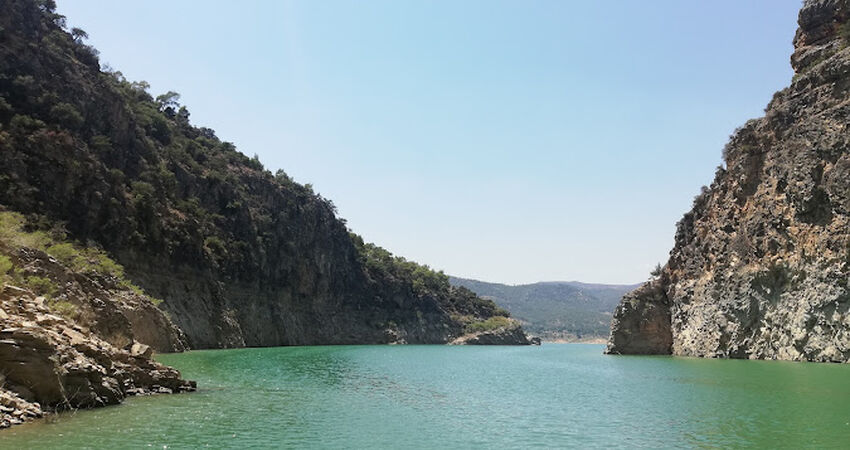
Arapapıştı Canyon, located in the Bozdoğan district of Aydın, is an impressive natural wonder formed by the erosion of the Akçay River over millions of years. Approximately 6 kilometers long and 380 meters high, this canyon lies at the intersection of the provinces of Aydın, Muğla, and Denizli. The emerald green waters fed by the Kemer Dam flow through the canyon, offering visitors a visual feast. In the narrowing parts of the canyon, the width decreases to 12 meters, while in some areas it widens enough for boat tours. This natural formation was opened to tourism by the Aydın Metropolitan Municipality in 2017.
Arapapıştı Canyon is notable not only for its natural beauty but also for its historical richness. The caves on the canyon’s slopes, known as “Sıra İnler,” have been used during different periods throughout history. Additionally, a rock tomb estimated to be about 2,500 years old from the Persian period is one of the important historical remains of the canyon. Visitors can explore these natural and historical beauties by joining boat tours organized in the canyon. There are also picnic areas and walking trails around the canyon, making it an ideal travel route for nature lovers.
4. Lake Bafa

Lake Bafa, one of the largest lakes in the Aegean Region, is located within the borders of Aydın and Muğla provinces. Covering an area of approximately 60 km², the lake was once part of the Aegean Sea. However, alluvial deposits carried by the Büyük Menderes River gradually filled this gulf, separating the lake from the sea and turning it into a freshwater lake today. The lake lies at the foothills of the Beşparmak Mountains and is surrounded by olive groves, pine forests, and maquis vegetation. Its shores are irregular, and it contains islets such as Menet, İkiz, and Hayalet Islands, which hold historical ruins.
Lake Bafa attracts attention not only with its natural beauty but also with its rich historical and cultural heritage. The village of Kapıkırı on the lake’s shore hosts the ruins of the ancient city of Heraclea. In this ancient city, structures such as the Temple of Athena, the agora, the theater, and the walls can be seen. Additionally, the Yediler Monastery located in the Beşparmak Mountains and the 8,000-year-old rock paintings shed light on the region’s prehistoric periods. Lake Bafa was declared a Nature Park in 1994 and hosts 224 bird species, making it an important center for bird watchers. Activities such as hiking, photography, and boat tours around the lake allow for exploration where nature and history intertwine.
🏖️ Beaches and Bays
5. Altınkum Beach (Didim)
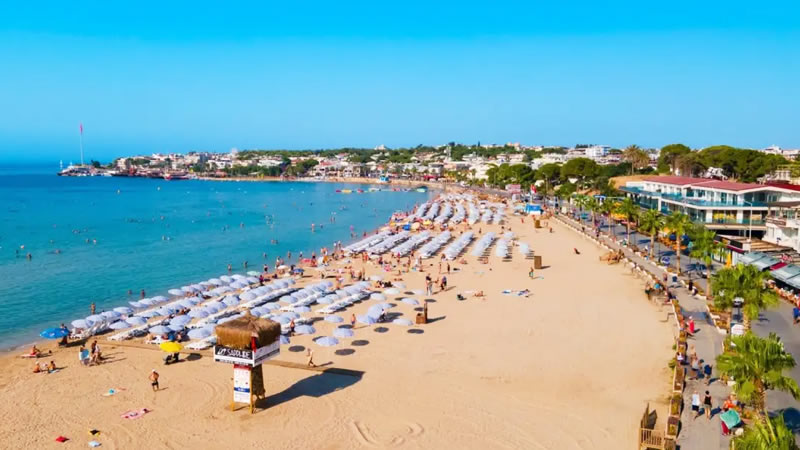
Altınkum Beach, located in the Didim district of Aydın, is known as one of the most popular beaches of the Aegean Sea. Named after its fine, golden-yellow sands, the beach offers an ideal swimming area especially for families and vacationers with children due to its clear and shallow sea. The beach, approximately 750 meters long and 15 meters wide, has been awarded the Blue Flag for its cleanliness and environmental management. Altınkum Beach is preferred also because of its easy access, being only 2 kilometers from the Didim city center.
The walking path along the beach offers visitors a pleasant stroll with sea views. Additionally, the cafes, restaurants, and entertainment venues located along the coastline provide options for relaxation and fun throughout the day. Boat tours departing from Altınkum Beach allow exploring the nearby bays and islands. Most of the hotels in Didim are located in the Altınkum area, increasing the variety of accommodation options.
6. Women’s Beach (Kuşadası)

Women’s Beach is a popular beach located in the Kuşadası district of Aydın, known for both its historical background and natural beauty. During the Ottoman period, this beach was reserved exclusively for women, but over time it was opened to everyone. Noted for its fine golden sands and clear sea, Women’s Beach attracts significant attention, especially in the summer months, with its 600-meter-long shoreline. The beach holds the Blue Flag award and stands out for its cleanliness and environmental management. Located approximately 3 kilometers from Kuşadası city center, it is preferred for its easy access.
Women’s Beach offers various facilities to visitors. In addition to basic services such as showers, toilets, and snack bars, there are options to rent sunbeds and umbrellas. Surrounded by many hotels, restaurants, and cafes, the beach provides rich options for accommodation and dining. Additionally, water sports activities such as jet skiing, parasailing, and water skiing can be done at the beach. With its unique sunset view, Women’s Beach offers an ideal setting for romantic walks and is a perfect destination for those looking to relax and have fun.
7. Aquarium Bay (Didim)
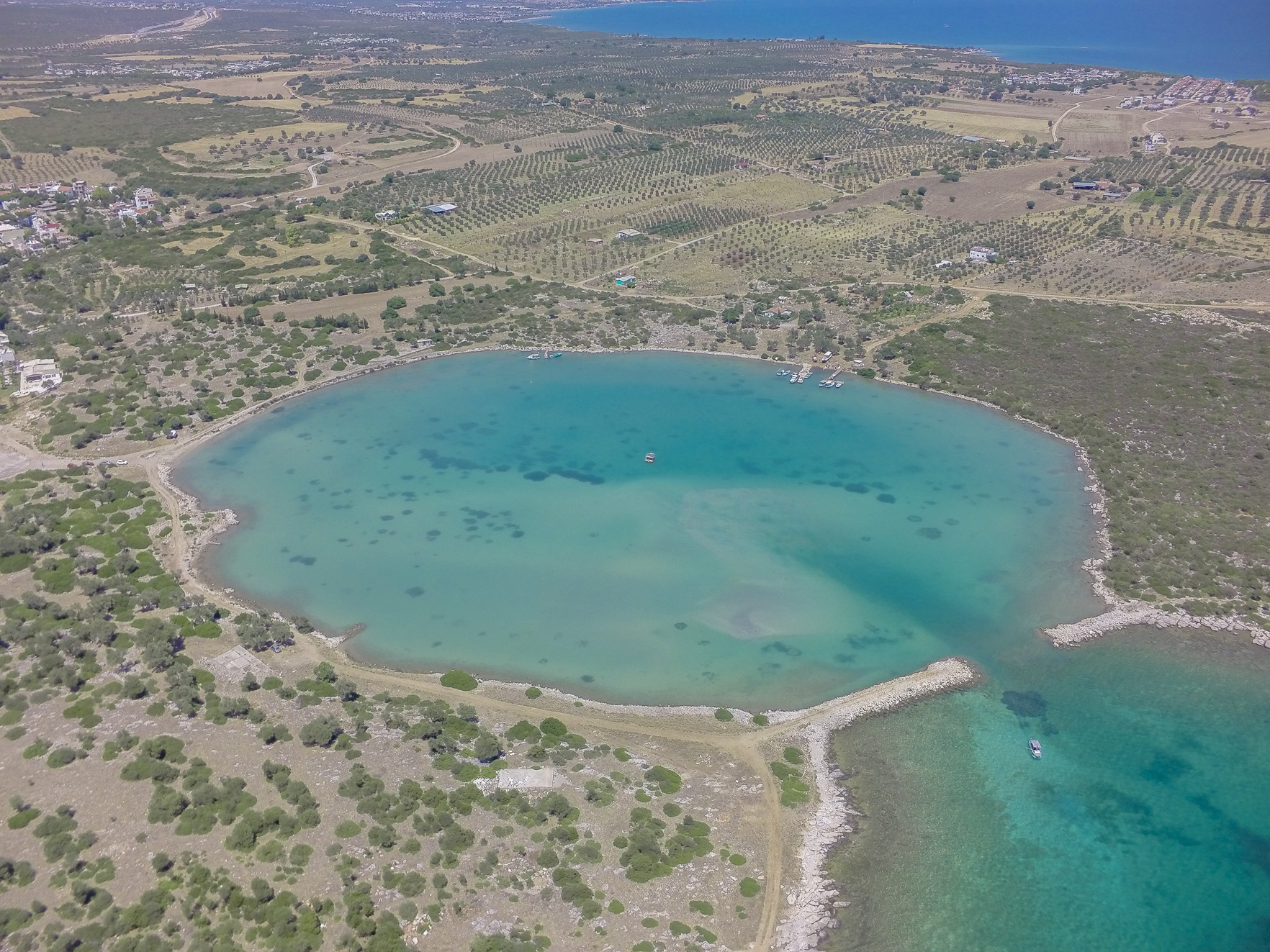
Aquarium Bay is a quiet bay located in the Didim district of Aydın, right next to the Zonguldaklılar Site, named after its clear, glass-like sea. The bay’s mouth is almost closed, and its waters are as calm as a lake. It was previously used as a fish farm. The bay has a sandy seabed and shallow waters, making it ideal for non-swimmers and families with children. However, there are no social facilities in the bay; therefore, visitors are advised to meet their needs beforehand.
Located near the Didim Police Moral Camp Area, Aquarium Bay is one of the bays visited by boat tours. There are seven beautiful and clean bays at the Didim Police Moral Training Center, also called the Academy Bays. The clear waters of Aquarium Bay are very suitable for snorkeling and underwater photography. Since there are no businesses around the bay, visitors are recommended to bring their food, drinks, and other necessities with them.
8. İçmeler and Aydınlık Bays
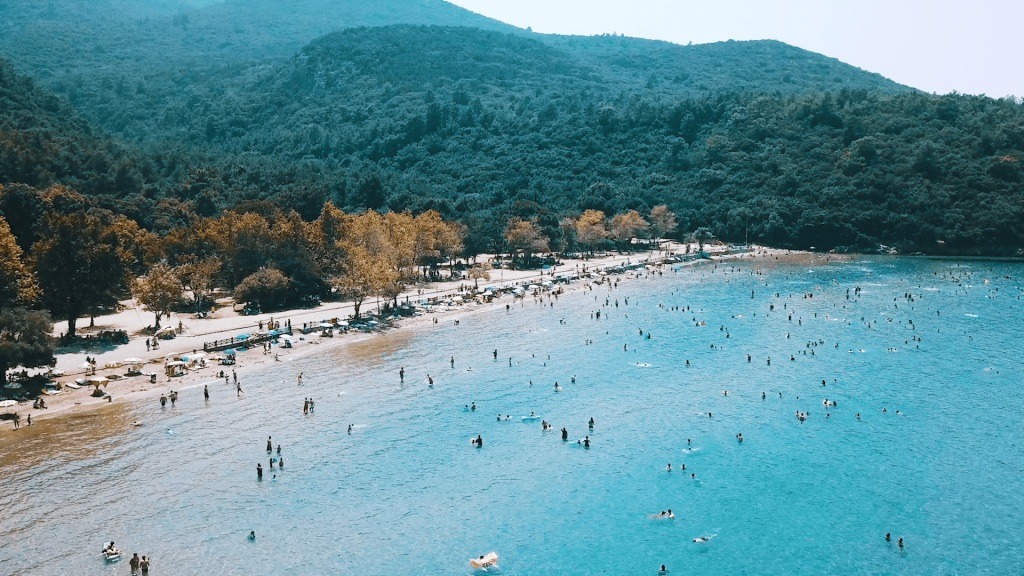
İçmeler and Aydınlık Bays are among the most popular natural beaches within the Dilek Peninsula-Büyük Menderes Delta National Park in the Kuşadası district of Aydın. İçmeler Bay is only 300 meters from the park entrance and is easily accessible by vehicle or on foot. Its shallow and sandy sea makes it especially ideal for families with children. The bay offers facilities such as free parking, showers, toilets, changing cabins, and picnic areas. Additionally, there is a restaurant operated by By Serkan serving breakfast and seafood. İçmeler Bay’s peaceful atmosphere and pine tree surroundings provide visitors with a tranquil experience.
Aydınlık Bay is located about 5 kilometers from the national park entrance and features an 800-meter-long shoreline. Its deep and clear sea is suitable for swimmers; however, extra caution is advised for families with children. The bay includes facilities such as a picnic area with a kiosk, sales booths, toilets, and large picnic grounds. Surrounded by pine trees, Aydınlık Bay’s natural setting and calm environment make it an ideal escape for nature lovers.
🏛️ Ancient Cities and Historical Sites
9. Aphrodisias Ancient City (Karacasu)
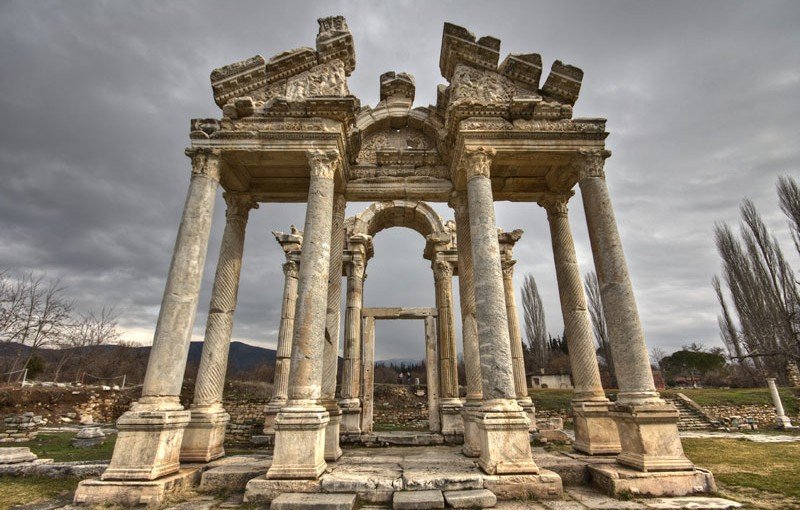
Aphrodisias Ancient City is located in the Geyre Neighborhood of Karacasu district in Aydın, situated on a fertile plateau approximately 600 meters above sea level. With a settlement history dating back to the 5th millennium BC, it was one of the important centers of the ancient Caria region. Named after Aphrodite, the goddess of love and beauty, the city experienced significant cultural and artistic development, especially during the Roman Empire period. Protected by Roman Emperor Augustus, Aphrodisias gained privileges such as tax exemption and autonomy, which contributed to the city’s rapid growth.
Aphrodisias hosts one of the best-preserved stadiums of the ancient world; this stadium, 270 meters long, has a capacity of about 30,000 people. Additionally, structures such as the Temple of Aphrodite, Sebasteion, theater, agora, and Hadrian’s Bath reflect the city’s architectural and artistic richness. The Aphrodisias School of Sculpture, known for producing high-quality marble statues, gained fame throughout the Roman Empire. Artifacts uncovered in archaeological excavations are exhibited in the Aphrodisias Museum, which is located right next to the ancient city and offers visitors a comprehensive historical experience.
10. Didyma Ancient City (Didim)

Didyma Ancient City, located in the Didim district of Aydın, is a sacred site that held great importance as an oracle center in ancient times. Dating back to the 8th century BC, it was dedicated to Apollo, the god of music, art, and prophecy. The temple was developed into a grand sanctuary during the peak period of Ionia in the 6th century BC, but was destroyed by the Persians in 494 BC. After Alexander the Great liberated the region from Persian rule, reconstruction began, but the temple was never completed. The temple measures 109 by 51 meters and is surrounded by 124 Ionic columns arranged in double rows. The inner courtyard contained a sacred spring and a small temple (naiskos). The architecture of the temple shows similarities to other major structures of the era, such as the Temple of Artemis at Ephesus and the Temple of Hera at Samos.
Didyma is notable not only for its architecture but also for its mythological and religious significance. According to legend, the god Apollo taught the secrets of prophecy to Brankhos, a shepherd in Didyma, and the Brankhids, his descendants, took charge of the temple’s administration. Priests and priestesses at the temple conveyed messages from the gods to petitioners through poetry during rituals. Additionally, Medusa reliefs found in the temple were used to ward off evil spirits. Didyma Ancient City today offers visitors the opportunity to closely explore the prophecy and belief systems of the ancient world.
11. Miletus Ancient City (Didim)
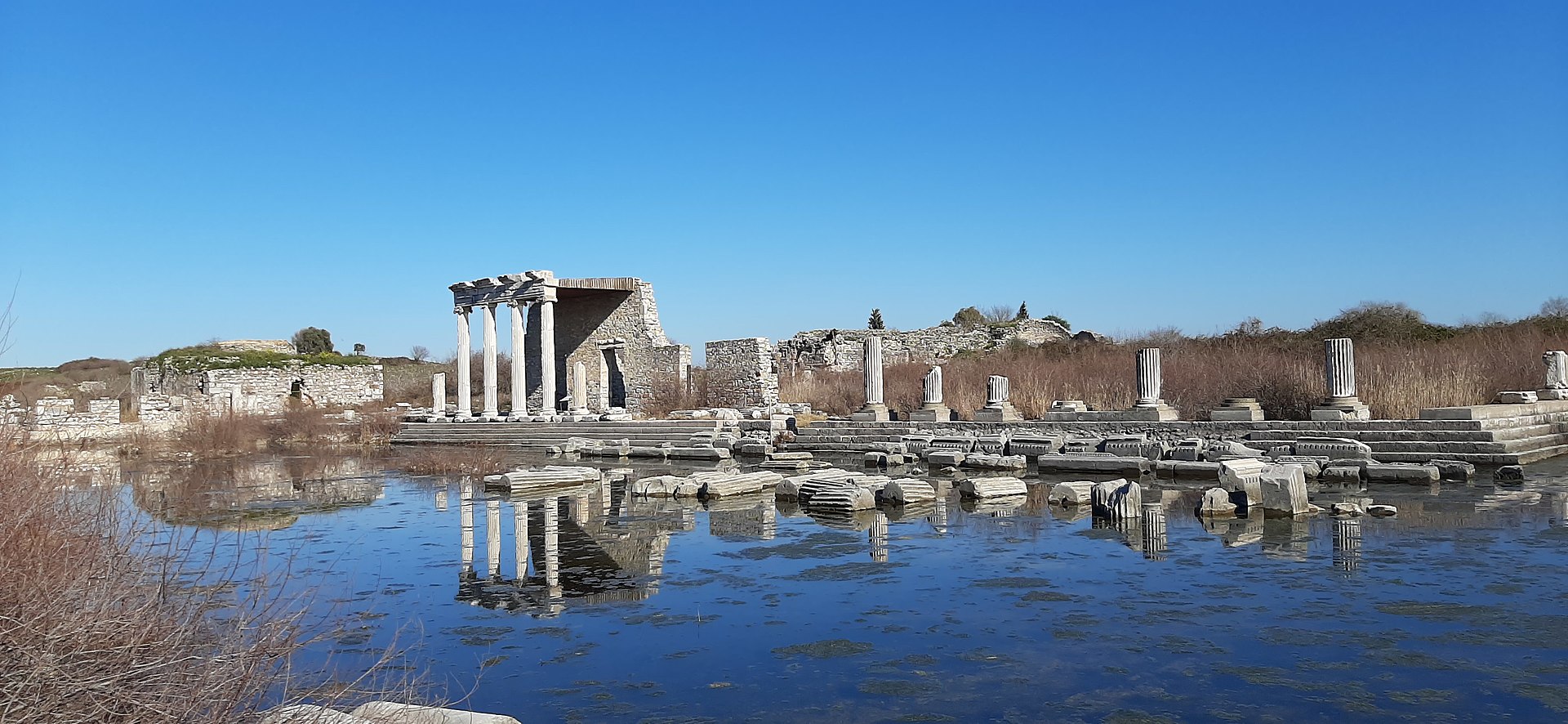
Miletus Ancient City is a settlement located near Balat village in the Didim district of Aydın province and is considered one of the most important port cities of the ancient world. With a settlement history dating back to 3000 BC, it has hosted many civilizations throughout history. As one of the largest and wealthiest cities of Ionia, Miletus gradually moved away from the sea due to the alluvial deposits carried by the Büyük Menderes River, settling in its current location. However, this geographical change did not diminish the city’s historical and cultural significance.
Miletus was a center where important figures in philosophy, science, and art emerged. Philosophers such as Thales, Anaximander, and Anaximenes lived here and contributed to the history of Western thought. Additionally, the grid-planned city layout by the urban planner Hippodamus was implemented in Miletus, serving as an important example in ancient city planning.
Today, Miletus Ancient City impresses visitors with its rich historical ruins. Structures such as the Roman theater with a capacity of 15,000 and renowned for its excellent acoustics, the Faustina Baths, agoras, gymnasium, and stoa reveal the city’s grandeur. Furthermore, artifacts unearthed during excavations at the ancient city are exhibited in the Miletus Museum.
Miletus, with its historical and cultural richness, is an important destination for both archaeology enthusiasts and history lovers. Located approximately 20 km from Didim, this ancient city offers a unique experience for those wishing to trace the traces of the past.
12. Nysa Ancient City (Sultanhisar)
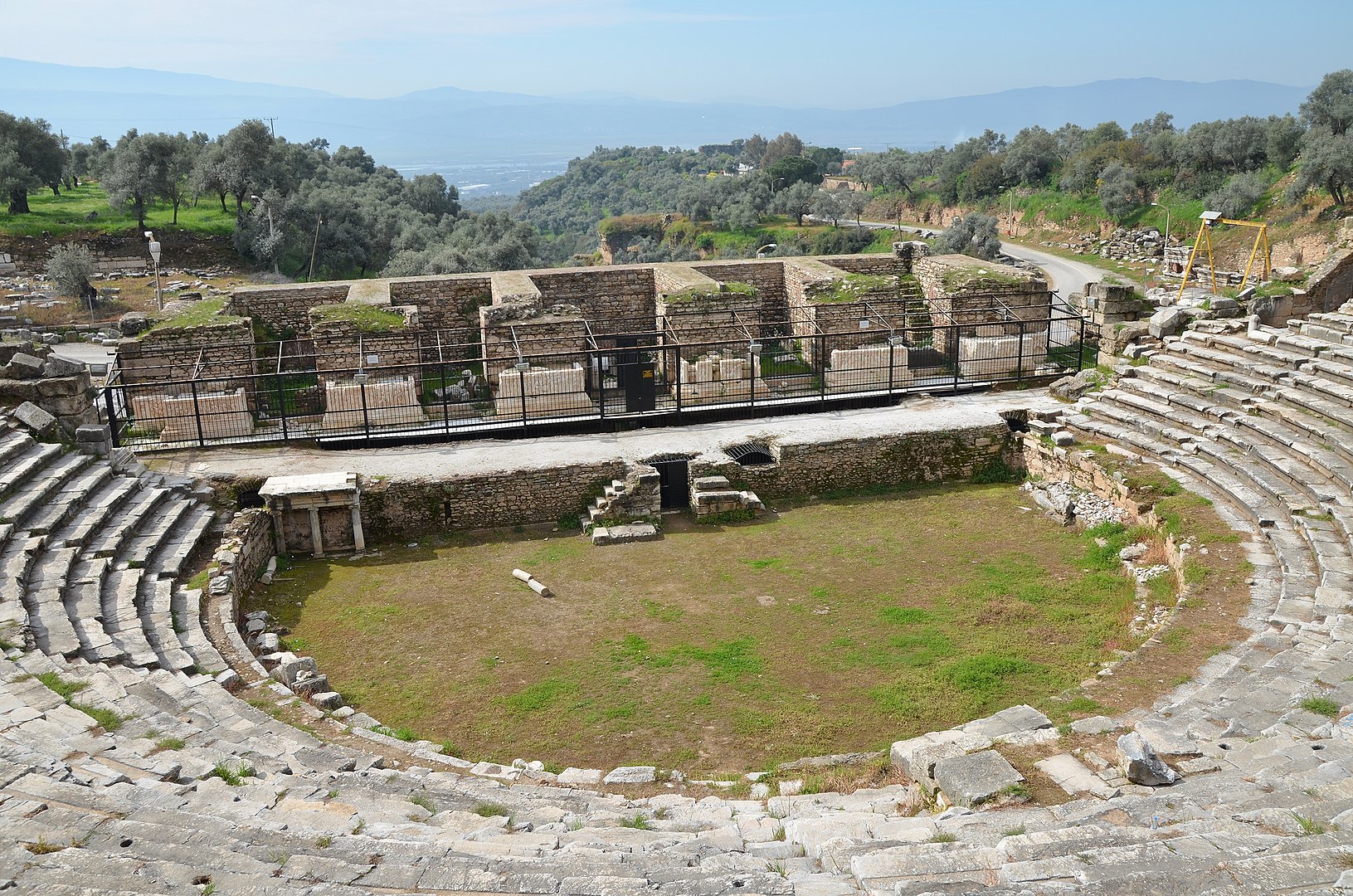
Nysa Ancient City is an important ancient settlement located 3 km northwest of the Sultanhisar district in Aydın province, on the northern bank of the Menderes River. Founded in the 3rd century BC, the city was originally known as “Athymbra” and later took the name “Nysa.” Regarding its founding, the famous geographer Strabo stated that the city was established by the merger of three different villages, while the historian Stephanos mentioned that it was founded by King Antiochus I Soter, son of Seleucus, in honor of his wife. Nysa held great cultural and educational significance, especially during the Roman Empire period; Strabo himself was educated in this city.
Today, Nysa Ancient City impresses visitors with its well-preserved structures. Among the most notable buildings are a large theater with a capacity of approximately 12,000, a stage building decorated with Roman reliefs, a two-story library, gymnasium, agora, and bouleuterion (council of elders). Additionally, the Nysa Bridge, located over a deep gorge dividing the city into two, is one of the longest bridges of the ancient world and an important engineering marvel. Nysa carries the traces of ancient times to the present day with its historical and cultural richness.
13. Tralleis Ancient City (Aydın Center)
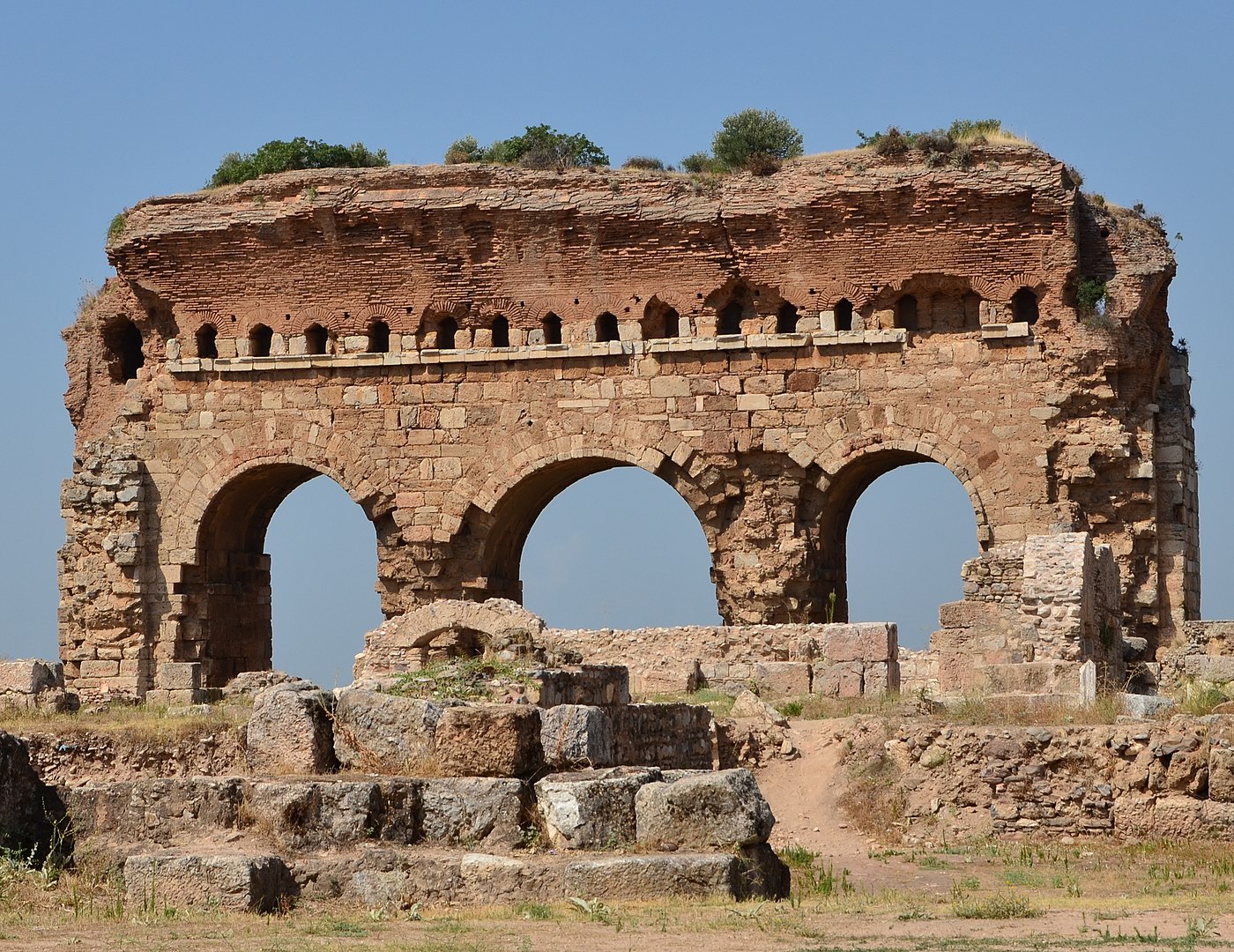
Tralleis Ancient City is an important ancient settlement located about 1 kilometer north of the center of Aydın province, on the southern slope of Kestane Mountain (Mesogis). The city is believed to have been founded in the 13th century BC by Thracians and Argives and came under the rule of Alexander the Great in 334 BC. During the Hellenistic period, Tralleis was governed by the Seleucids and Attalids, and it became an important city in the Roman era. The city developed in agriculture, trade, and industry due to its fertile lands and strategic location; it became especially renowned in sectors such as leatherworking, weaving, ceramics production, and olive oil manufacturing.
Among the standing structures in Tralleis today, the “Three Eyes,” the remains of a Roman-era gymnasium complex, stand out. This building was one of the important centers of education, sports, and culture in ancient times. Additionally, the city contains structures such as a theater, bathhouse, agora, and stadium. Tralleis was also a center where many famous figures lived; for example, sculptor Apollonios, mathematician and architect Anthemios, physician Alexander, and writer Phlegon all lived here. Artifacts found during excavations in Tralleis are exhibited at the Aydın Archaeology Museum.
🏺 Museums and Cultural Sites
14. Aydın Archaeology Museum (Efeler)
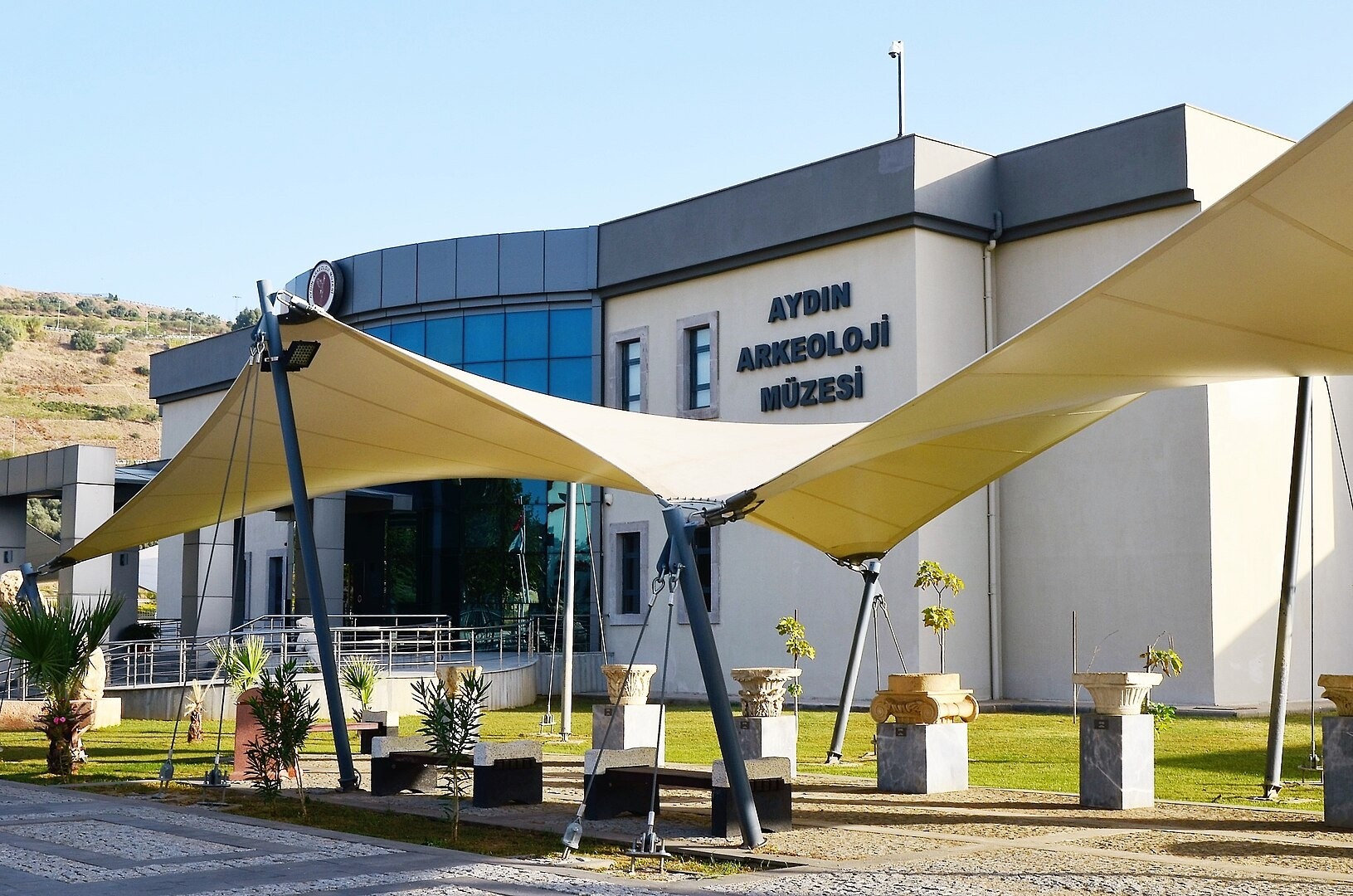
Aydın Archaeology Museum is an important cultural heritage center located on Müze Boulevard in the Efeler district of Aydın province. Established in 1959 in a room of Zafer Primary School, the museum moved to its new building in 1973 and acquired a modern structure in 2012. Today, with approximately 11,000 archaeological, 4,000 ethnographic artifacts, and 45,000 coins, it is considered one of the most comprehensive museums in Turkey.
The museum consists of three main sections exhibiting artifacts from ancient cities such as Tralleis, Magnesia, Alinda, Alabanda, Nysa, Amyzon, Piginda, Harpasa, Myus, Pygela, Orthosia, and Mastaura. There are a total of 10 exhibition halls: Tepecik Tumulus Hall, Archaic Panionion Hall, Kadıkalesi (Anaia) Hall, Alabanda Hall, Tralleis Hall, Magnesia Hall, Nysa Hall, Mosaics Hall, Stone Artifacts Hall, and Coin Hall. The museum is open every day of the week from 08:30 to 17:00 and accepts the Museum Card (MüzeKart).
Aydın Archaeology Museum is an important destination for those wishing to explore the region’s rich historical past. With its modern exhibition techniques and extensive collections, it offers visitors insights into ancient Anatolia.
15. Yörük Ali Efe Museum (Yenipazar)
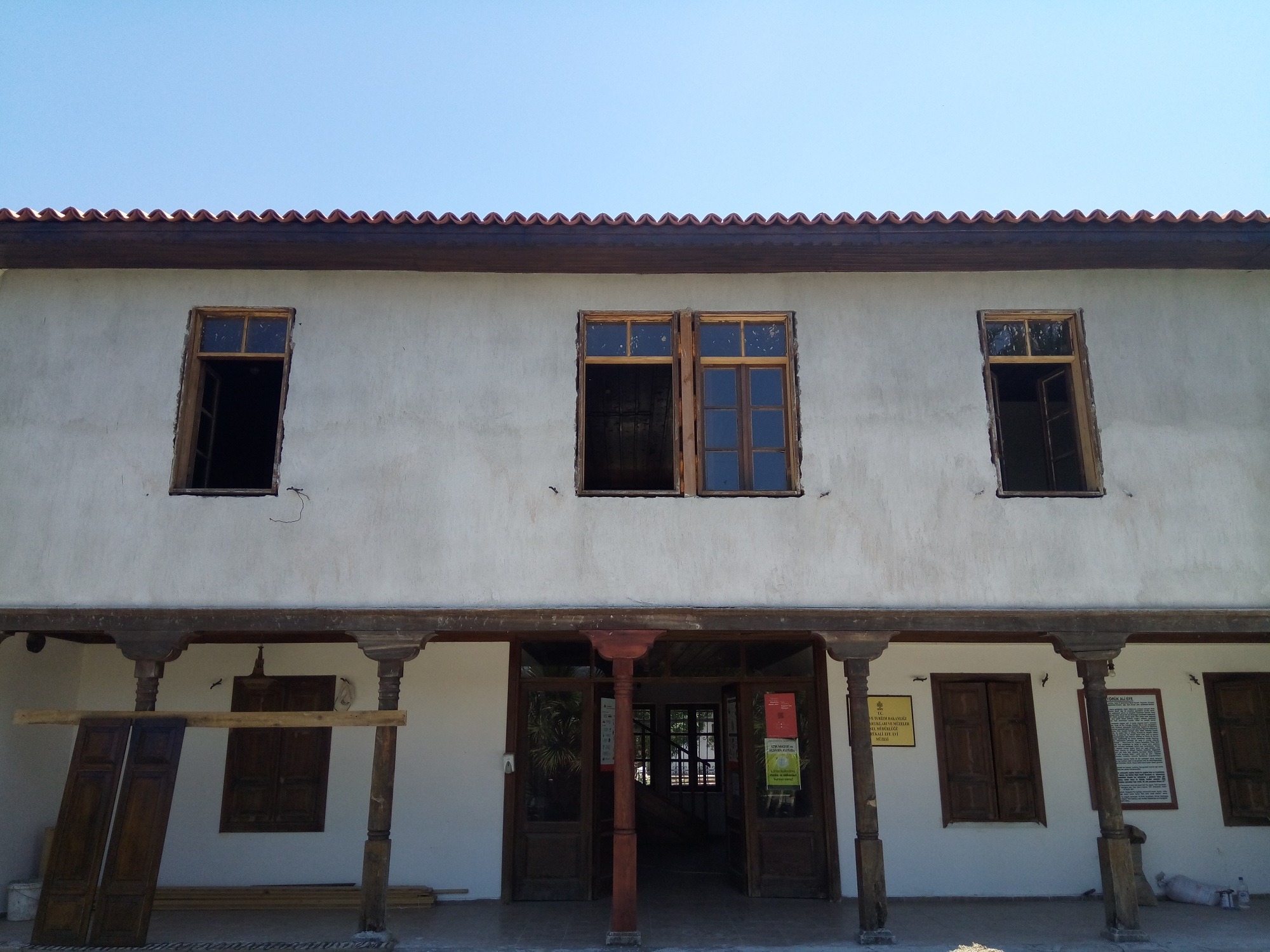
Yörük Ali Efe Museum is located in the Çarşı Neighborhood of Yenipazar district in Aydın province and aims to preserve the life and struggle of Yörük Ali Efe, one of the important figures of the Turkish War of Independence. Born in 1895, Yörük Ali Efe was one of the leading leaders of the Kuva-yi Milliye movement and resisted occupying forces in the Aydın region. The museum was opened to visitors in 2001 after being restored in accordance with the original house where Yörük Ali Efe lived from 1928 until his death. The museum building is an example of traditional Turkish house architecture dating back to the late 19th century.
The museum exhibits personal belongings of Yörük Ali Efe, photographs related to the War of Independence, and ethnographic artifacts. Additionally, Yörük Ali Efe’s grave and statue in the museum garden attract visitors’ attention. The museum is open daily from 08:30 to 17:30, admission is free, and it can be visited with the Museum Card. Yörük Ali Efe Museum is an important destination for history enthusiasts and those wishing to trace the legacy of the War of Independence.
16. Oleatrium Olive and Olive Oil Museum (Kuşadası)
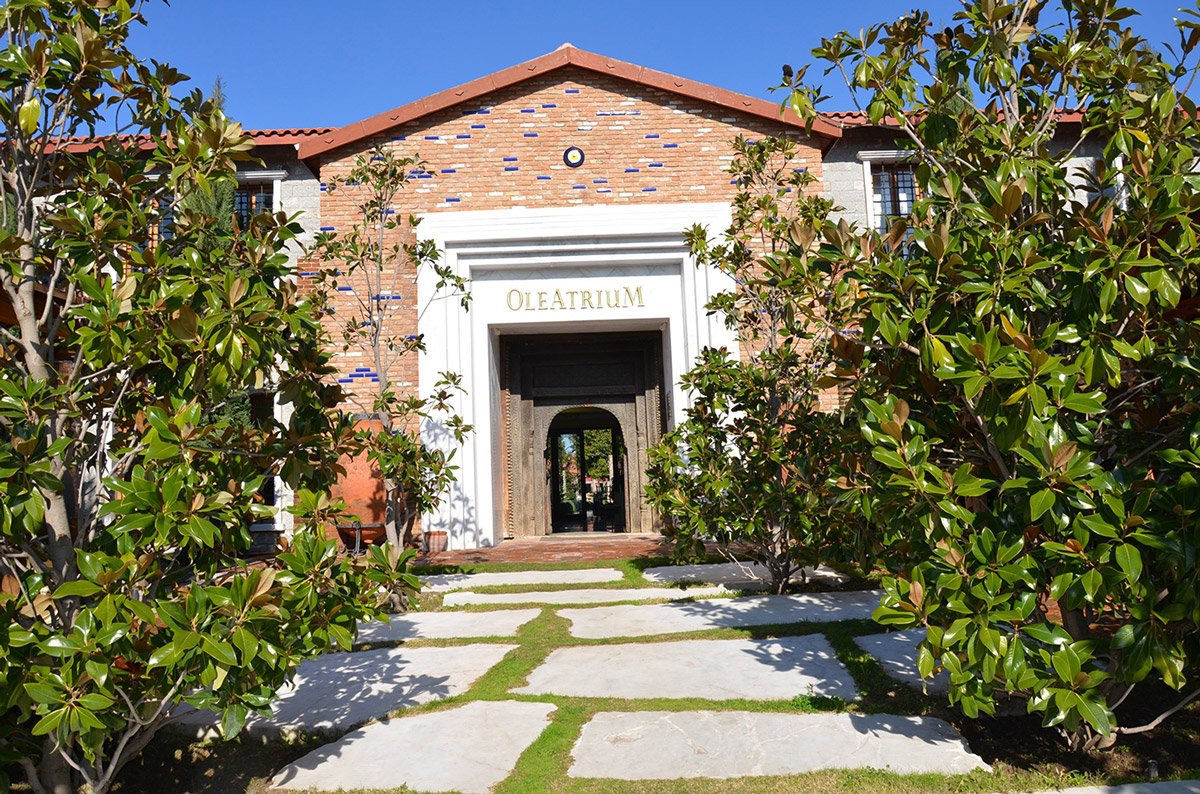
Oleatrium Olive and Olive Oil Museum is a special museum located on Davutlar Road in the Kuşadası district of Aydın province, dedicated to the history of olives and olive oil. Established in 2011, the museum was created with a collection gathered over more than 30 years by retired English teachers Hasan and Gürsel Tonbul. The museum’s name, derived from the Latin words “olea” (olive) and “atrium” (courtyard), means olive courtyard. Covering a total area of 3,000 m², the museum consists of outdoor and indoor gardens, a lobby, and 11 exhibition halls. Each hall displays different historical periods and production stages of olives in detail, offering visitors a comprehensive experience.
The museum is open every day except Sunday from 10:00 to 18:00. Admission fees are 50 TL for full price and 30 TL for reduced price, while children under 13, disabled persons, families of martyrs, and ICOM cardholders enter free. Group visits require prior reservation. Beyond being an exhibition space, the museum also contributes through educational activities and publications about olive oil production and olive culture. Visitors can also participate in experiences such as olive oil and wine tasting.
🏰 Other Historical and Natural Sites
17. Güvercinada Castle (Kuşadası)

Güvercinada Castle is a historic structure located on Güvercinada, an island in the Kuşadası district of Aydın province, named for being a resting place for birds and connected to the mainland by a breakwater in the 1950s, forming a peninsula. This castle, one of Kuşadası’s symbols, dates back to the Byzantine period and underwent significant repairs during the Ottoman era. Today, entrance to the castle is free and offers visitors a historical journey.
The castle currently functions as a museum and displays various historical artifacts. Visitors can climb the castle to observe panoramic views of Kuşadası and enjoy the blue expanse of the Aegean Sea. Additionally, the views from the castle at sunset create unforgettable memories.
18. Saplı Ada (Didim)

Saplı Ada is an island located in the Akbük town of Didim district in Aydın province, known for its natural beauty. Situated approximately 100 meters from the Akbük coast, the island can be reached on foot via a path connected to the mainland when the sea level is low. This feature offers an experience similar to Kızkumu in Marmaris.
The island was formed by the accumulation of ash and lava spread during a major volcanic eruption in the Aegean Sea around 1500 BC. Today, the volcanic ash layers beneath the island’s surface are still observable. Covering an area of approximately 8 hectares, Saplı Ada is a protected natural site, and construction is not permitted on it.
Visitors can reach the island on foot and explore the surrounding nature trails. It also provides a suitable environment for birdwatching. Since there are no facilities on the island, it is recommended to bring your own food and drinks. While there are no restrictions on visiting hours, it is important to maintain cleanliness in the area.
Saplı Ada, with its natural beauty and peaceful atmosphere, is an ideal destination for nature lovers and those seeking a tranquil getaway.
19. Kurşunlu Monastery (Kuşadası)
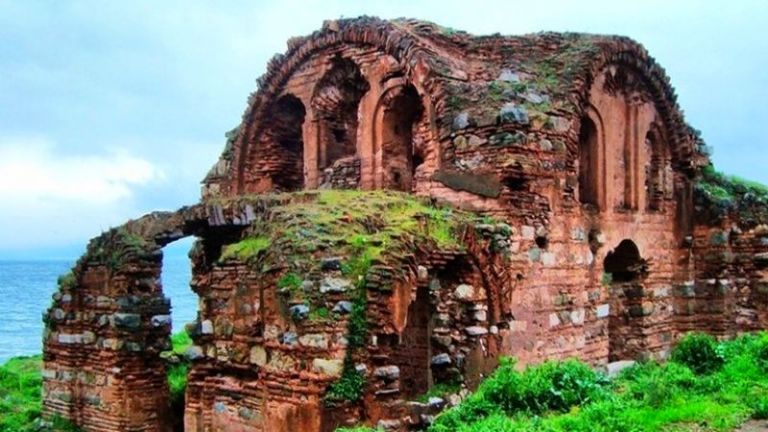
Kurşunlu Monastery is a historic Byzantine structure located in the Davutlar Neighborhood of Kuşadası district in Aydın province, within the boundaries of Dilek Peninsula National Park, approximately 600 meters above sea level. It was built in the 8th century by monks who fled persecution to spread Christianity. The name of the structure comes from the lead material used on its roof. The monastery is notable for its Byzantine architectural features and, although it has suffered significant damage over time, it remains open to visitors today.
The monastery includes sections such as a dining hall, pantry, kitchen, monk cells, infirmary, chapel (small church), cemetery, monastery walls, wall cellar, and defense rooms. The frescoes on the chapel ceiling depict symbolic and geometric motifs from the Iconoclastic period and religious events or figures from the second half of the 9th century. The monastery is part of trekking and safari routes for nature lovers and is an important destination for those wishing to explore the historical and natural beauties of the region.
20. Arpaz Beyler Mansion (Nazilli)
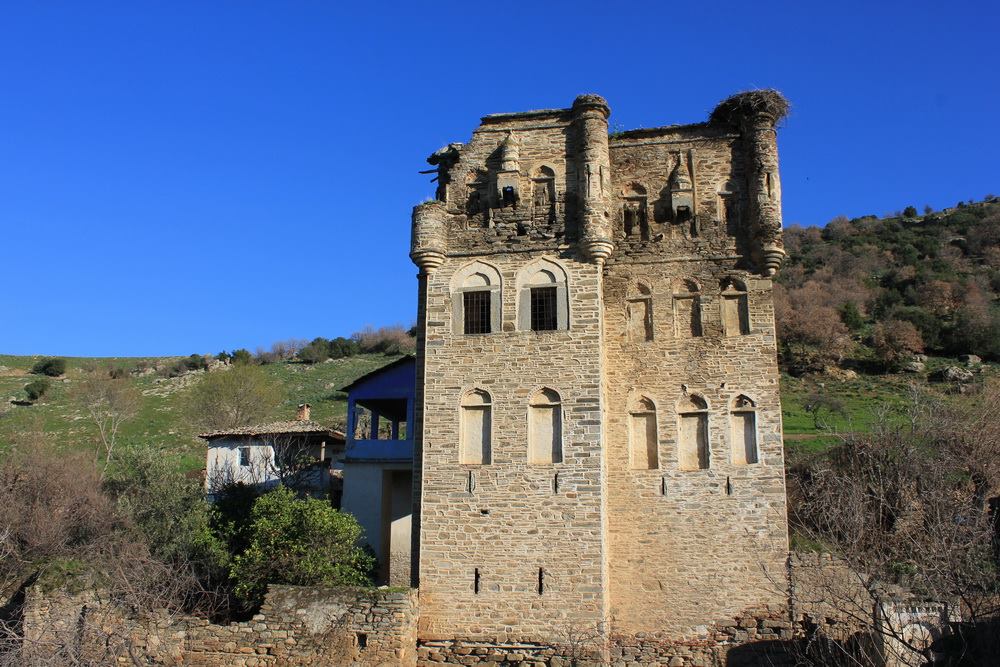
Arpaz Beyler Mansion is a historic building located in the Esenköy neighborhood (formerly called Arpaz) of Nazilli district in Aydın province, at the foot of the ancient city of Harpasa. Built in the 19th century, this mansion was used as the residence of local lords during the late Ottoman period. Constructed by the Arpaz family, the building has survived to the present as an important example reflecting the social and cultural structure of the era.
The mansion stands out with its tower, bathhouse, fountain, pool, auxiliary buildings, and elegant woodwork. Details such as the pinwheel motifs on the ceilings, carved cabinet doors in the high-ceilinged rooms, and the master bathroom in the bridal chamber reveal the lifestyle of the period and the craftsmanship of the artisans. Arpaz Beyler Mansion is considered one of Nazilli’s most important historical and cultural buildings and offers visitors the opportunity to trace the traces of the past.
